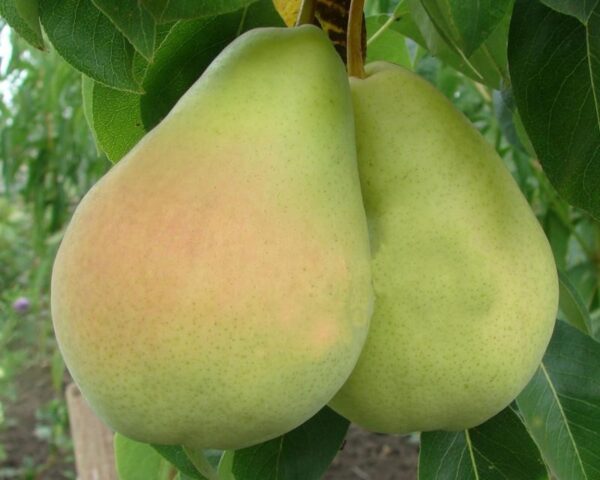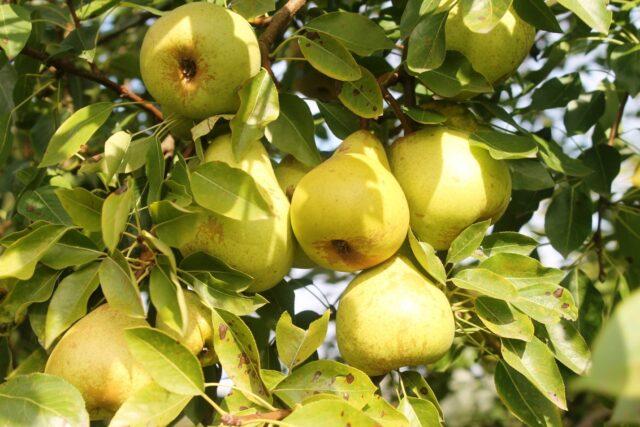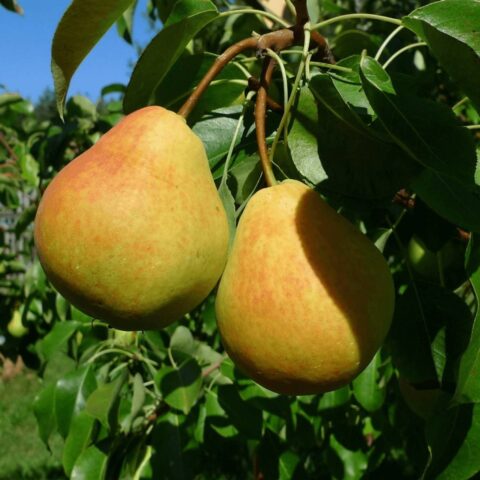Content
Summer pear varieties are a group of varieties of early and medium ripening periods. They usually produce a harvest in the middle - second half of August. In some cases, pears appear in July and even at the end of June. When choosing seedlings, you should take into account the climatic characteristics of the region, taste and yield.
Features of summer ripening pears
The main feature of early ripening pear varieties is that they bear fruit from the end of July to the beginning of September. The harvest period can be very different.
Since the fruits form early, they have time to ripen while still on the branch. Although the crop is often harvested a week earlier to increase shelf life. The fact is that pears of most summer varieties are stored for no more than 14 days, they need to be consumed immediately, and also used for preparing preparations.
As a rule, the fruits are small in size. The average weight is from 80 to 150 g, but there are also larger pears up to 180-200 g. Taste and yield greatly depend on the variety.When choosing a variety, it is necessary to take into account the climatic features of the region.
Mostly summer pear varieties in Russia are grown in the south, in the Black Earth Region. Many crops are allowed to be grown in the Volga region and the middle zone. Some winter-hardy varieties are grown in the Urals and even in Siberia and the Far East.
The best varieties of summer (early) pears with descriptions and photos
When choosing delicious summer pear varieties, you first need to take into account the cultivation goals and climatic characteristics of the region. The most popular varieties with photos are described below.
August dew
August dew is a summer variety of early ripening pears. The fruits appear in mid-August. They adhere well to trees and do not fall off, so they can be removed within several weeks. Stored in the refrigerator or cellar for up to 15 days. Marketability is quite high and reaches 90%.

Fruits of the August dew are regular in shape, with a blush
The variety is characterized by high winter hardiness; it can be grown in the Black Earth Region and the middle zone. Is immune to scab. Productivity is quite high - fruiting begins in the fourth season and continues annually. Productivity reaches 200 c/ha. In high-yield years, the fruits become somewhat uneven.
When growing, it is necessary to plant pollinators; the best variety is the Yakovlev Memory variety.
Lada
Lada is another early fruiting pear. This is one of the most common summer varieties. It is distinguished by early fruiting - the first harvest is formed already 2-4 years after planting the seedling. The culture is winter-hardy and adapts to frost. Therefore, it can be planted not only in spring, but also in autumn.Another advantage is that it is self-fertile; the variety does not need pollinators. The tree is small, grows up to 3.5 m and does not take up much space. Adapts well to different climatic conditions.

Lada pears are small but very tasty
The harvest begins to ripen in mid-August. The fruits are medium in size, reaching 100-110 g in weight. They are quite shelf-stable and can be stored for up to 60 days at a temperature of about 0 degrees. The taste is good, tasting score 4.3 points. The yield reaches 50 kg. At the same time, the fruits are not fragrant and not transportable.
Bashkir summer
Another early ripening pear, bears fruit in the first and second ten days of August. They are small in size, weighing on average 70-80 g. The surface is smooth, even, and the shape is symmetrical. At the same time, the skin is rough and oily. The color is yellowish-green, becoming lighter as it ripens, and a blush appears.

The Bashkir Summer variety produces pears in mid-August
The pulp is white, moderately dense, juicy and aromatic. The taste is sweetish and sour, at the tasting it received a rating of 4.0 points out of 5, in appearance - 4.3 out of 5. The fruits are not long-lasting - they are stored in the refrigerator or cellar for no more than 15 days. The yield is quite high - from 9 to 16 t/ha. Marketability is average, while the fruits are transportable. They contain quite a lot of sugars - almost 8% mass fraction, while the acidity is no more than 0.5%.
Whiteleaf
This variety of summer pears is represented by large, medium-sized trees up to 4.5 m high. The branches are straight and thick. The fruits are small, weighing from 60 to 110 g, slightly ribbed, dry. The color is light yellow, with a diffuse pinkish blush.
The pulp is white, with a creamy tint. The taste is sweet and sour, the aroma is weak. Sugars by mass fraction 8.4%, acids no more than 0.3%.Therefore, the taste is quite good, slightly astringent, dry, and a faint aroma is noticeable.
Pears of this summer variety appear at the end of August. Fruiting begins 5-6 years after planting. Productivity is average, estimated at 30-33 kg per mature tree. Pears can be stored in the refrigerator and cellar for a maximum of 10 days. They are not so good fresh, but they are ideal for compotes.

Belolistka fruits are sweet and aromatic
Chizhevskaya
Chizhevskaya is one of the earliest varieties of pears. The fruits ripen in mid-August. They can be harvested green and then allowed to sit in a cool place to improve their taste. Pears are quite large, reaching an average weight of 120-140 g. The shape is obovate, the surface is smooth, with subcutaneous points. A slight rustiness is noticeable, the blush is blurry, faintly visible, and has a pinkish tint.
The taste of the fruits of this summer variety is sweet and sour, refreshing. The sugar content is quite high - more than 9% mass fraction, acids - no more than 0.5%. The pulp is white, with a light yellow tint, semi-oily, moderately juicy. Gives a faint aroma, melts in the mouth.

Regularly shaped fruits with an orange blush
Unlike many other summer varieties, the Chizhevskaya pear produces very shelf-stable fruits. They can be stored for up to 120 days if maintained at a stable temperature of 0 degrees. Marketability is high, but transportability is average. Yield up to 560 kg per mature tree.
Victoria
The Victoria variety is also a summer variety, although the fruits ripen somewhat later than other representatives. Usually the harvest is harvested from the end of August to the first ten days of September. Pears are medium and large, weight ranges from 150 to 200 g, but sometimes specimens weigh up to 300 g.
The fruits are aligned, symmetrical, and have the correct shape. The skin is of medium thickness, the surface is smooth, the color is yellowish-green with a pinkish-purple blush. There are many subcutaneous points, they are small, but clearly visible.

Victoria's pulp is sweet, juicy, oily, white in color
The taste is very pleasant, with pronounced sweetness and balance of sour. At the tasting it received a rating of 4.5 points out of 5 possible. Sugar content 7.8%, acids no more than 0.4%.
Great Summer
This is an early summer variety that produces pears in the second half of August. The fruits are quite large, average weight 170-190 g. The skin is greenish-yellow in color, with a faint blush. There are many small subcutaneous dots on the surface, and rustiness is noticeable.
The pulp is white, quite dense and juicy, semi-oily. A pleasant aroma is pronounced. Taste with a balance of sour and sweet. The fruits do not fall off and the harvest is easy enough to harvest. Fruiting begins in the fourth year after planting.

Pears are yellowish in color
The variety is quite demanding on soils and needs fertile, light soils. Seedlings are planted in open areas without stagnant moisture and the absence of high (more than 2 m) groundwater.
July
July is one of the earliest summer varieties. The fruits ripen from July 10 to July 15 and can be stored for up to 10 days. Trees of medium vigor, with a crown of moderate density. The branches are straight, reaching upward. The bark is greenish and peeling.
The pears themselves are medium in size, weighing 120 g. They are bottle-shaped, the surface is smooth and delicate, and does not shine in the sun.The color is yellowish-green, then becomes lemon yellow, and a bright blush appears on the sunny side. The stalks are long and curved.

Regularly shaped pears with attractive colors
The pulp is white, juicy, delicate consistency. The taste is pleasant, balanced, sweet and sour. At tasting it is rated 4.0-4.3 points out of 5.0. The mass fraction of sugars exceeds 7%, acids – no more than 0.25%.
June beauty
The pear is an Italian selection, produces small fruits weighing up to 60 g. The shape is elongated, pear-shaped, somewhat flattened. The skin is dry, smooth, and shines in the sun. The pulp is yellowish, juicy, and gives a very pronounced aroma. The taste is average, acid and sugar are faintly felt.

Red color, symmetrical shape
Flowering is early, and the variety needs pollinators. The best options are Vilyamovka, Fetelova and Conferans. The color of the fruit is greenish, rusty spots are noticeable, and on the sunny side there is a red blush. They appear already in the second half of June. Even if storage conditions are met, they last no more than 14 days. Therefore, fruits should be consumed fresh and used for preparing preparations.
Duchess summer (Williams)
Summer Duchess is one of the oldest summer varieties. The variety was bred back in 1796. In Russia, variety testing began in 1947. The trees are medium-sized, the crown is broad-leafed, asymmetrical, pyramidal in shape. Harvests are abundant, especially in the period of 10-12 years, reaching 200-250 kg per tree.
The shoots are thick, straight, strong, and hold fruit well. The fruits themselves are medium or large, weight 170-200 g, oblong-pear-shaped, the surface is slightly bumpy. The skin gives off a pleasant aroma, the color is light green, then becomes yellowish, and a faint blush is noticeable.

Fruit can be picked already at the end of June
The pulp is white, with a yellow tint, tender and melting, quite juicy, and has a nutmeg aroma. The taste is dessert, balanced. The fruits ripen in the second half of August and can be stored for quite a long time - up to 45 days.
Carmen
Carmen is an early summer pear, represented by a fast-growing tree reaching 5 m in height. The crown is dense and compact, narrowly pyramidal, so up to 12 seedlings can be placed on one acre. Fruits of regular shape, average weight 120-170 g, individual specimens up to 300 g. The skin is slightly rough, glistens in the sun. The color is burgundy, brownish-red. Numerous bright spots are visible.

The first harvest is harvested in the fifth year after planting
The pulp has a light aroma, moderately dense, semi-oily type. The color is light cream. Taste with a balance of sour and sweet, without astringency. Sugars contain approximately 8% of the total mass, acidity is not more than 0.15%.
The variety is not the most early-bearing - the harvest begins to form in the 5-6th year of life. But fruits appear quite quickly - from late July to mid-August. Consumption period up to 14 days. The fruits cannot be stored for long periods of time; they must be used for harvesting.
Severyanka
Severyanka is a summer pear variety bred at the Michurin Research Institute. Zoned across all major regions of Russia - from the Volga-Vyatka and central zone to the Urals, Siberia and the Far East. The variety is winter-hardy, which is why it received the appropriate name.
The fruits are formed from the first half of August to mid-September (depending on the climatic characteristics of the area and care). Pears are small in size, weight 80-85 g, individual specimens up to 120 g. The shape is truncated-conical. The color is yellowish-green, the blush is weak and blurry.The skin is matte, does not shine in the sun, is dense and thick, but not rough.

The crop can be cultivated even in Siberia
The pulp is cream-colored, moderate in density, juicy, crispy. The aroma is weak, the taste with a balance of sour and sweet, satisfactory. The sugar content is high - almost 12%, acids - no more than 0.4%. Pears of this summer variety are stored for no more than 14 days, after which the flesh turns brown. If harvested a week before full ripening, the crop can be stored for up to two months at a temperature of 0-2 degrees Celsius.
Cathedral
Cathedral is a summer pear variety. The harvest ripens in the second half of August - early September. Fruits from 110 to 130 g, regular pear-shaped, bumpy surface. The skin is smooth and delicate, giving a glossy sheen. The color is light yellow, the integumentary blush is weak, reddish. The stalks are quite thick.
The pulp is sweet and sour, juicy, semi-oily, has a fine-grained structure, and medium density. The taste is good - 4.0 out of 5 points. The total proportion of sugars is 8.5%, acids within 0.3%.

The taste is sweet, the flesh is juicy
The variety is early-bearing and produces an annual harvest. In this case, the fruits remain for no more than 12 days. Transportability is average, so it is necessary to process at or near the harvest site. Table pear, suitable for making dried fruits and compotes.
Summer oily
Summer oilseed is another pear variety that produces a harvest in late August. The fruits are stored for up to two weeks, the weight reaches 150-170 g, the shape is regular pear-shaped. The skin is yellowish-green, there is a slight tan of orange color. The pulp is juicy, tender, semi-oily. The taste is very good, with a balance of sweet and sour.

Trees can be grown in different soils
Early fruiting is average - fruits begin to form only five years after planting. Gardeners note that this summer variety is undemanding to soil composition. However, for a good harvest, regular watering and fertilizing will be required.
Limonka
Lionka is a summer pear variety that produces tall trees (up to 6 m) with a wide crown (up to 5.7 m) of a rounded shape. The fruits are small, weighing up to 100 g, smooth, ovoid in shape. The name refers to the lemon-yellow uniform color (without blush). Subcutaneous points are numerous, distributed over the entire surface.
The ripening period occurs at the end of August. The variety is summer, so the pears do not last long (within seven days). The pulp is greenish in color, dense, sour, taste is mediocre. Sugars make up 10% by weight, acids within 0.2%.

The name refers to the characteristic lemony hue of the fruit.
Conclusion
Summer varieties of pears are intended mainly for processing, making preserves, jams, drying and other homemade preparations. The fruits are mostly small, moderately sweet, and last within two weeks, less often up to 1-2 months. Such crops bloom early, which is important to take into account when choosing pollinators.
Reviews of summer pear varieties








